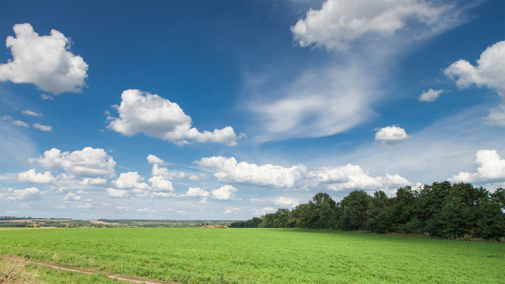Fertilizing Cool-season Grass
Fertilizing cool-season grass pastures or hayfields is something producers do each year while accounting for forage needs, the value of the forage and fertilizer costs. Something very important to remember this year is precipitation and soil moisture status, as that moisture is needed to realize the grass response to the fertilizer.
Fertilization of smooth bromegrass pastures should occur late March through April. If the nitrogen is a single application, usually between 80 to 100 lbs of actual N per acre is suggested for eastern Nebraska. The recommended application rate declines westward across the state with about 30 to 40 lbs N per acre suggested for the Panhandle.
If doing split applications, usually it's two-thirds in the spring and a third in the fall when growth resumes on the cool-season grasses. With fertilized pasture, be sure to include a rotational grazing plan that will effectively harvest the extra forage and provide the greatest return on the fertilizer investment. Also remember that adequate moisture is needed with fertilizer applications.
Soil tests could also be conducted to determine more exact amounts needed, particularly for any phosphorus, potassium or sulfur that could be applied.
Research conducted in eastern Nebraska has shown a 30% increase in forage yield with fertilization, and the economic optimum rate is between 80 to 120 lbs per acre. A crude protein increase from 16% to 20% was seen with fertilizer applications up to 160 lbs. That is a lot of fertilizer, but it did increase crude protein and organic matter digestibility while decreasing neutral detergent fiber (NDF). Always be aware when applying fertilizer, especially in pastures and fields near water sources such as ponds.
Brome pastures are hardy, and we can and do graze them hard in Nebraska. Haying or grazing operations can benefit if managed correctly with fertilizer.
Alfalfa Early Season Weed Control
Spring is a critical time to control weeds in alfalfa, especially for thin alfalfa stands with fields older than four years. If interseeding forages, such as oats, or rotating to an alternative crop are not viable options for thin fields, then the next strategy will likely be controlling grassy and broadleaf weeds while they are still small. When weeds grow faster than stressed alfalfa, seedlings are robbed of moisture, nutrients and light. Left uncontrolled, weeds can thin stands, weaken plants and lower yields.
For broadleaf weeds, mowing may be an option while the alfalfa is growing slowly. Adjust mowing height so several leaves remain on the seedlings after clipping to aid in alfalfa regrowth. However, if mower clippings may smother young alfalfa seedlings, then alternative herbicide application may still be your best weed control option.
For Round-up Ready® or RR tolerant varieties, glyphosate applications sprayed in early spring can assist alfalfa in effectively overcoming emerging weeds. When establishing new alfalfa stands, Eptam®, Balan DF® and Trust® are labeled. For seedling alfalfa, post-emergent herbicides include AIM®, Moxy 2E®, Poast®, Buctril®, Raptor®, Select Max®, Prowl H²O®, Warrant®, Pursuit®, Metribuzin, Arrow®, Glyphosate and Butyrac 200®.
For established alfalfa, labeled broadleaf or grassy herbicides include Aim®, Moxy 2E®, Butytrac®, Chateau®, Gramoxone®, Karmex®, Metribuzin®, Prowl H²O®, Treflan®, Arrow®, MCPA Amine®, Warrant®, Glyphosate and Velpar®.
Remember that improved herbicide effectiveness begins with applying products early while the weed are less than four inches tall. More details regarding alfalfa weed control herbicide comparisons are available in the 2025 Nebraska Extension publication EC130, “Guide for Weed, Disease and Insect Management”.
Grazing Spring Cereal Grains
Grazing winter annuals such rye, winter wheat or triticale commonly begins in April. All three of these forages can be very high in quality and reduce the need for feeding expensive hay while allowing additional time for spring growth of our perennial summer pastures.
Timing grazing should depend plant growth, not a specific date. Begin grazing when the plants are about five to six inches tall and manage to keep the maximum height at eight to 10 inches. A good starting point is about 0.5 cow or one stocker calf per acre in early spring and increasing from there. Rotational grazing with higher stocking densities can assist with keeping the plant maturity more uniform and reduce selective grazing. Look ahead one or two pastures and move based on how the plants are recovering in those pastures. These forages grow and recover from grazing fast.
The most common mistake when grazing spring small cereals is letting the grass get ahead of the cattle. It is important to increase stocking density as the spring progresses to ensure grazing can keep up with the rapid forage growth. This can be achieved by either adding more cattle or reducing the number of acres being grazed.
Like most cool-season grasses in early spring, small cereal forages are also high in potassium. This means there is a need to provide supplemental magnesium as potassium interferes with magnesium availability to the animal. A free choice mineral with a targeted 4 oz. per day intake should contain at least 10% magnesium to prevent grass tetany in lactating cows and 5% magnesium to increase gains in stocker calves.

